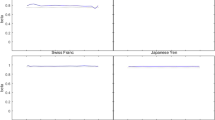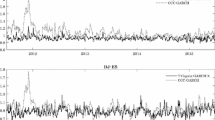Abstract
Under martingale and joint-normality assumptions, various optimal hedge ratios are identical to the minimum variance hedge ratio. As empirical studies usually reject the joint-normality assumption, we propose the generalized hyperbolic distribution as the joint log-return distribution of the spot and futures. Using the parameters in this distribution, we derive several most widely used optimal hedge ratios: minimum variance, maximum Sharpe measure, and minimum generalized semivariance. Under mild assumptions on the parameters, we find that these hedge ratios are identical. Regarding the equivalence of these optimal hedge ratios, our analysis suggests that the martingale property plays a much important role than the joint distribution assumption.
To estimate these optimal hedge ratios, we first write down the log-likelihood functions for symmetric hyperbolic distributions. Then we estimate these parameters by maximizing the log-likelihood functions. Using these MLE parameters for the generalized hyperbolic distributions, we obtain the minimum variance hedge ratio and the optimal Sharpe hedge ratio. Also based on the MLE parameters and the numerical method, we can calculate the minimum generalized semivariance hedge ratio.
Access this chapter
Tax calculation will be finalised at checkout
Purchases are for personal use only
Similar content being viewed by others
References
Adams, J., & Montesi, C. J. (1995). Major issues related to hedge accounting. Newark: Financial Accounting Standard Board.
Atkinson, A. C. (1982). The simulation of generalized inverse Gaussian and hyperbolic random variables. SIAM Journal of Scientific and Statistical Computing, 3, 502–515.
Barndorff-Nielsen, O. E. (1977). Exponentially decreasing distributions for the logarithm of particle size. Proceedings of the Royal Society London A, 353, 401–419.
Barndorff-Nielsen, O. E. (1978). Hyperbolic distributions and distributions on hyperbolae. Scandinavian Journal of Statistics, 5, 151–157.
Barndorff-Nielsen, O. E. (1995). Normal inverse Gaussian distributions and the modeling of stock returns. Research Report no. 300, Department of Theoretical Statistics, Aarhus University.
Bawa, V. S. (1975). Optimal rules for ordering uncertain prospects. Journal of Financial Economics, 2, 95–121.
Bawa, V. S. (1978). Safety-first, stochastic dominance, and optimal portfolio choice. Journal of Financial and Quantitative Analysis, 13, 255–271.
Bibby, B. M., & Sørensen, M. (2003). Hyperbolic processes in finance. In S. T. Rachev (Ed.), Handbook of heavy tailed distributions in finance (pp. 211–248). Amsterdam/The Netherlands: Elsevier Science.
Bingham, N. H., & Kiesel, R. (2001). Modelling asset returns with hyperbolic distribution. In J. Knight & S. Satchell (Eds.), Return distribution in Finance (pp. 1–20). Oxford/Great Britain: Butterworth-Heinemann.
Blæsid, P. (1981). The two-dimensional hyperbolic distribution and related distribution with an application to Johannsen’s bean data. Biometrika, 68, 251–263.
Chen, S. S., Lee, C. F., & Shrestha, K. (2001). On a mean-generalized semivariance approach to determining the hedge ratio. Journal of Futures Markets, 21, 581–598.
Chen, S. S., Lee, C. F., & Shrestha, K. (2003). Futures hedge ratio: A review. The Quarterly Review of Economics and Finance, 43, 433–465.
De Jong, A., De Roon, F., & Veld, C. (1997). Out-of-sample hedging effectiveness of currency futures for alternative models and hedging strategies. Journal of Futures Markets, 17, 817–837.
Eberlein, E., & Keller, U. (1995). Hyperbolic distributions in finance. Bernoulli, 1, 281–299.
Eberlein, E., Keller, U., & Prause, K. (1998). New insights into smile, mispricing and value at risk: The hyperbolic model. Journal of Business, 71, 371–406.
Fishburn, P. C. (1977). Mean-risk analysis with risk associated with below-target returns. American Economic Review, 67, 116–126.
Harlow, W. V. (1991). Asset allocation in a downside-risk framework. Financial Analysts Journal, 47, 28–40.
Howard, C. T., & D’Antonio, L. J. (1984). A risk-return measure of hedging effectiveness. Journal of Financial and Quantitative Analysis, 19, 101–112.
Johnson, L. L. (1960). The theory of hedging and speculation in commodity futures. Review of Economic Studies, 27, 139–151.
Kücher, U., Neumann, K., Sørensen, M., & Streller, A. (1999). Stock returns and hyperbolic distributions. Mathematical and Computer Modelling, 29, 1–15.
Lien, D., & Tse, Y. K. (1998). Hedging time-varying downside risk. Journal of Futures Markets, 18, 705–722.
Lien, D., & Tse, Y. K. (2000). Hedging downside risk with futures contracts. Applied Financial Economics, 10, 163–170.
Lien, D., & Tse, Y. K. (2001). Hedging downside risk: Futures vs. options. International Review of Economics and Finance, 10, 159–169.
Price, K., Price, B., & Nantel, T. J. (1982). Variance and lower partial moment measures of systematic risk: Some analytical and empirical results. Journal of Finance, 37, 843–855.
Rydberg, T. H. (1997). The normal inverse Gaussian Levy process: Simulation and approximation. Communications in Statistics: Stochastic models, 13, 887–910.
Rydberg, T. H. (1999). Generalized hyperbolic diffusion processes with applications in finance. Mathematical Finance, 9, 183–201.
Scott, W. (1979). On optimal and data-based histograms. Biometrika, 33, 605–610.
Author information
Authors and Affiliations
Corresponding author
Editor information
Editors and Affiliations
Rights and permissions
Copyright information
© 2015 Springer Science+Business Media New York
About this entry
Cite this entry
Lee, CF., Lee, JY., Wang, K., Sheu, YC. (2015). A Generalized Model for Optimum Futures Hedge Ratio. In: Lee, CF., Lee, J. (eds) Handbook of Financial Econometrics and Statistics. Springer, New York, NY. https://doi.org/10.1007/978-1-4614-7750-1_94
Download citation
DOI: https://doi.org/10.1007/978-1-4614-7750-1_94
Published:
Publisher Name: Springer, New York, NY
Print ISBN: 978-1-4614-7749-5
Online ISBN: 978-1-4614-7750-1
eBook Packages: Business and Economics




